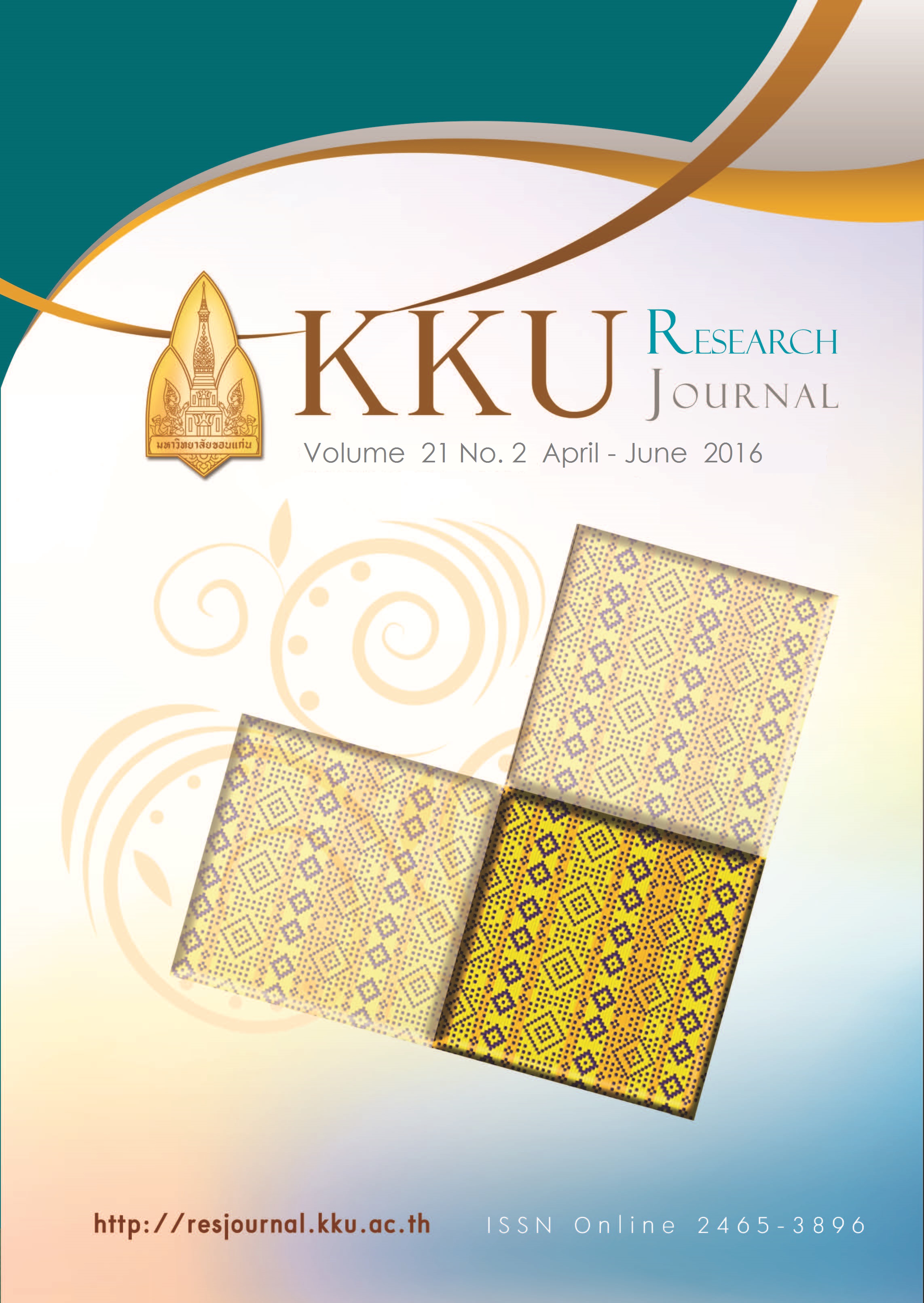Preparation of vinegar from coconut water using baker’s yeast and acetobacter aceti TISTR 102 starter powder
Main Article Content
Abstract
In order to produce vinegar, coconut water was fermented through two stages: alcoholic fermentation with baker’s yeast and followed by acetous fermentation with A. aceti TISTR 102 starter powder. The baker’s yeast and the sugar concentration significantly effected on the alcoholic fermentation (p≤0.05). Baker’s yeast at 0.4% (w/v) was added to 1,500 mL of coconut water at 12% (w/v) sugar content that adequately produced approximately 6% (v/v) ethanol concentration within 1 day. The ethanol was used as the substrate for acetification with A. aceti TISTR 102 starter powder. The addition of A. aceti TISTR 102 starter powder at 0.5% (w/v) completely produced 6.27±0.02% acetic acid within 18 days, thus attaining 89% fermentation efficiency. In the sensory evaluation test, the coconut water vinegar was rated with acceptable scores for all of the sensorial attributes (appearance, odor, sourness and overall acceptance). Vinegar from coconut water is one considered and application in household scale.
Article Details
References
[2] Asli MS. A study on some efficient parameters in batch fermentation of ethanol using Saccharomyces cerevesiae SC1 extracted from f e r m e n t e d s i a h e s a r d a s h t pomace. African Journal of Biotechnology. 2010; 9(20): 2906-2912.
[3] Brian JBW. Microbiology of Fermented Foods. USA: Springer US; 1998.
[4] Charoenchai C, Fleet GH and H e n s c h k e PA . E f f e c t s o f temperature, pH, and sugar concentration on the growth rates and cell biomass of wine. American Journal of Enology and Viticulture. 1998; 49(3):283-288.
[5] Claro FB, Rijsbrack K and Soares E V. F l o c c u l a t i o n o n s e t i n Saccharomyces cerevisiae: effect of ethanol, heat and osmotic stress. Journal of Applied Microbiology. 22 Aug 2007; 102(3):693-700.
[6] Dubois M, Gilles KA, Hamilton JK, Rebers PA and Smith F. Colorimetric method of sugars and related substances. Analytical Chemistry. 1956; 28:350-356.
[7] Grahovac J, Dodić J, Jokić A, Dodić S and Popov S. Optimization of ethanol production from thick juice: A response surface methodology approach. Fuel. March 2012; 93:221-228.
[8] Hutkins RW. Microbiology and Technology of Fermented Foods. Chicago, U.S.A: Blackwell Publishing; 2008
[9] Kim SH, Cho HK and Shin HS. Physicochemical properties and antioxidant activities of commercial vinegar drinks in Korea. Food Science and Biotechnology. 31 December, 2012; 21(6):1729-1734.
[10] Kocher GS, Kalra KL and Phutela RP. Comparative production of sugarcane vinegar by different immobilization techniques. Journal of the Institute of Brewing. 2006; 112(3):264-266.
[11] Kumoro AC, Rianasari D, Pinandita APP, Retnowati DS and Budiyati CS. Preparation of wine from jackfruit (Artocarpus heterophyllus lam) juice using baker’s yeast: Effect of yeast and initial sugar concentrations. World Applied Sciences Journal. 2012; 16(9):1262-1268.
[12] Lin Y, Zhang W, Li C, Sakakibara K, Tanaka S and Kong H. Factors effecting ethanol fermentation using Saccharomyces cerevisiae (BY4742). Biomass and Bioenergy. December 2012; 47:395-401.
[13] L o t o n g N , M a l a p a n W, Boongorsrang A and Yongmanitchai W. Production of vinegar by Acetobacter cells fixed on a rotating disc reactor. Applied Microbial and Biotechnology. 1989; 32:27-31.
[14] Matloob MH. Zahdi Date Vinegar: Production and Characterization. American Journal of Food Technology. 2014; 9(5):231-245.
[15] Nagodawithana TW, Castellano C and Steinkraus KH. Effect of dissolved oxygen, temperature, initial cell count, and sugar concentration on the viability of Saccharomyces cerevisiae in rapid fermentations. Applied microbiology. 1974; 28(3):383-391.
[16] Ndip, R. N., Akoachere, J. F., Dopgima, L. L. and Ndip, L. M. 2001. Characterization of yeast strains for wine production. Applied Biochemistry and Biotechnology. 2001; 95(3): 209-220.
[17] Perlman D. Vinegar: its history and development. In Advances in Applied Microbiology, volume 20th. USA: Academic press; 1976.
[18] Seesuriyachan P, Kuntiya A and Techapun C. Exopolysaccharide production by Lactobacillus confusus TISTR 1498 using coconut water as an alternative carbon source: the effect of peptone, yeast extract and beef extract. Sonklanakarin Journal of Science and Technology. 2011; 33(4): 379-387
[19] Sossou SK, Ameyapoh Y, Karou SD and Souza CD. Study of pineapple peelings processing into vinegar by
biotechnology. Pakistan Journal of Biological Sciences. 2009; 12(11):859-865
[20] Truong VD and Marquez ME. Handling of coconut water and clarification of coco vinegar for small scale production. Annals of Tropical Research. 1987; 9:13-23.
[21] Valli M, Sauer M, Branduardi P, Borth N, Porro D and Mattanovich D. Intracellular pH distribution in Saccharomyces cerevisiae cell populations, analyzed by flow cytometry. A p p l i e d a n d Environmental Microbiology. 2005; 71(3):1515-1521.
[22] Unagul P, Assantachai C, Phadungruengluij S, Suphantharika M, Tanticharoen M. and Verduyn C. Coconut water as a medium additive for the production of docosahexaenoic acid (C22:6n3) by Schizochytrium mangrovei Sk-02. Bioresource Technology. January 2007; 98:281-287.
[23] Wongsudaluk W. Production of Acetobacter aceti TISTR 102 Starter Power by Low-Temperature Thermal Drying. MSc Thesis, Food Science and Nutrition, Faculty of Science and technology, Prince of Songkla University, Thailand.
2012.


